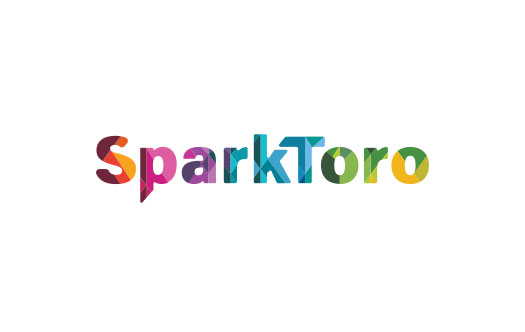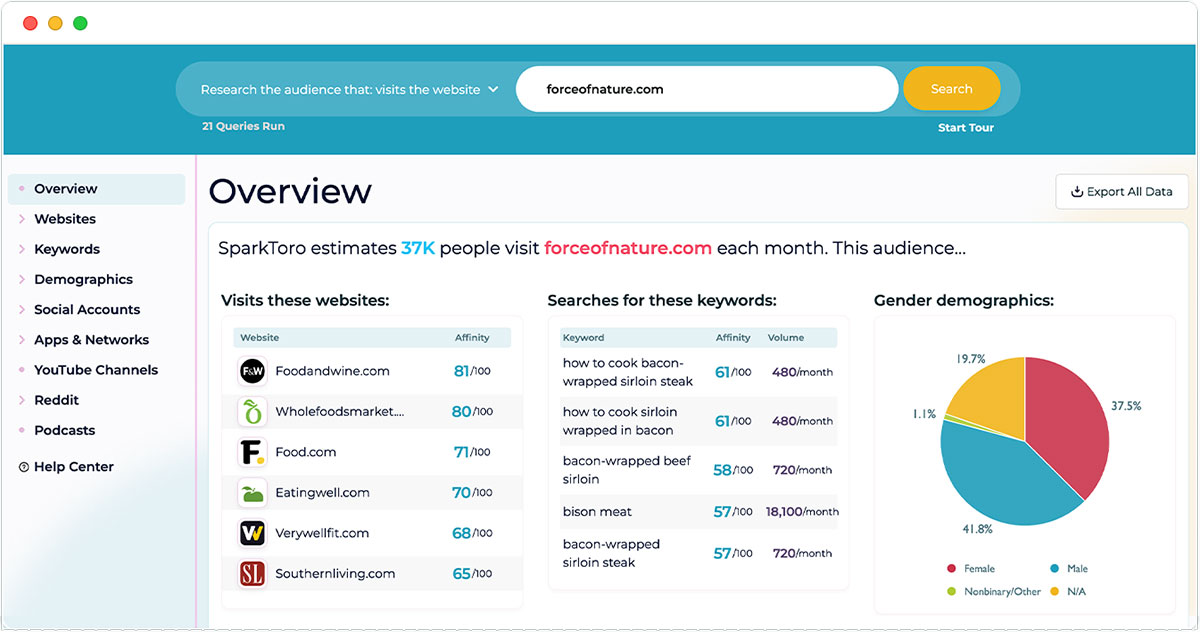TL;DR
After a major disruption stalled SparkToro’s growth, co-founder Rand Fishkin turned to Balsamiq to rethink their product from the ground up. By wireframing a new version of the UI based on deep user research, the SparkToro team rebuilt smarter, shipped faster, and reignited momentum.
At a glance
- Company: SparkToro
- Industry: Technology & Software
- Use case: UI/UX redesign, feature development, growth strategy
- Company size: Indie
- Key result: Big boost in sign-ups and retention after redesigning the product’s UI using Balsamiq

Meet SparkToro
Rand Fishkin is co-founder and CEO of SparkToro, an audience research platform that helps marketers understand where their audience spends time online. He’s also behind indie gaming company, Snack Bar Studio, and a soon-to-be-announced tech startup, and is widely known as a speaker and author in the marketing world.
He’s used Balsamiq for low-fidelity wireframing and product decision making at all three companies. But it played a particularly critical role in SparkToro’s recent product turnaround, something many companies are trying to do these days.

When your product works... but no one gets it
After years of steady growth, SparkToro hit a wall.
In 2023, Twitter (SparkToro’s main data source back then) shut off API access. The platform had changed, users lost trust, and the quality of SparkToro’s insights took a hit.
Rand and his co-founder (and lead developer), Casey, quickly rebuilt the product using new data sources like clickstream and SERP data.
It worked, from a technical point of view. But growth stalled, churn crept up, and no amount of marketing could fix it.
“There was a lot of tension,” Rand says.
Even with just two people, their workflow felt broken: a giant whiteboard, Google Slides, screenshots, endless emails. It was slow, hard to align on, and impossible to scale…especially for a remote-first team.
They knew the product needed a bigger rethink. But where do you start when it’s not a tech problem—it’s a clarity problem?
Using Balsamiq to build what’s next
Rand was reintroduced to Balsamiq at an event hosted at Balsamiq’s Bologna office. It quickly became their go-to product thinking tool and core to their turnaround.
Here’s how they overhauled the product:
Research: They brought in Asia Orangio from DemandMaven to conduct Jobs To Be Done–style interviews—and show wireframed concepts to users. The goal was to understand what didn’t click in the current product.
Insights: They discovered customers weren’t using SparkToro for tactical execution. Instead, they used it to make the case for new strategies—sharing audience data in internal decks to convince teams and stakeholders. So CSV exports weren’t as useful as clear, shareable graphs.
Wireframes: But you can’t jump from insights to Figma or code. Rand and Casey used Balsamiq to turn those insights into UI ideas—fast and collaboratively.
Validation: They shared early versions with customers to test layout and flow.
Design: Then, a design contractor, Monty Hayton, translated the wireframes into high-fidelity mockups. (They typically stop at wireframes, but the design system needed a refresh.)
Build: The new SparkToro launched in 2025—and quickly changed the trajectory of the business.
Since their relaunch, SparkToro’s churn rate dropped by half, and new signups grew by 15-20%!
It's the same audience data that was there before. We just changed how we presented it. That’s it. And it made a crazy amount of difference.


Of course, the research they did with Asia helped a ton. But translating her insights into what people see mattered.
Balsamiq comes into play in that arena between “you have discovered the problem your customers actually want to solve” and “now you need to translate that to how's the product going to do that.”
How Rand uses Balsamiq
Translate user research into product concepts: Wireframes help turn abstract insights into concrete solutions, especially when customers don’t know exactly how to ask for what they need.
Define flow and hierarchy of information: Helps decide what shows up first, second, third—in SparkToro’s case, based on what users need to understand or screenshot.
Replace slow, messy workflows: Balsamiq replaced giant whiteboards, Google Slides, and pen/paper for Rand and Casey.
Align product, design, and dev: Wireframes help Rand and Casey get aligned fast, and communicate clearly with outside designers.
Stay focused on function over polish: The sketchy look encourages structure-first thinking. No one mistakes it for a final design.
Plan new features with technical constraints in mind: Even when ideas start with technical limitations, they wireframe solutions before building.
What’s in Rand’s Balsamiq workflow:
He relies on pre-made UI elements
He shares wireframes with technical and design minds
He adds feedback and technical notes to consider dependencies
Now they’re wireframing what’s next in their industry
As more users export SparkToro data into AI tools like ChatGPT or Claude, Rand and Casey are exploring how to integrate AI functionality directly.
So they’re back in Balsamiq, wireframing how that experience might work in-product.
This time, the technical limitations are driving the UX decisions. But the process is the same: clarify the problem, wireframe the experience, then build the right thing—faster.
In Rand’s words:
I don’t think we ever would’ve solved the problem without going through the wireframing stage first. We couldn’t just take Asia’s research and hand it to Monty and expect great design to appear. That would be like skipping the architect and going straight to the builder, saying, ‘Hey, we want the kitchen on the second floor—go build it.’ But what kind of kitchen? Where exactly? What about the rest of the house? That’s why you need an architect. That’s why you need blueprints. That’s why you need wireframes.
Of course, this turnaround wasn’t just about wireframes. It was the combination of clear user insights, a tight team, and fast iteration. But Balsamiq played a crucial role in making that clarity visible—and shareable.

